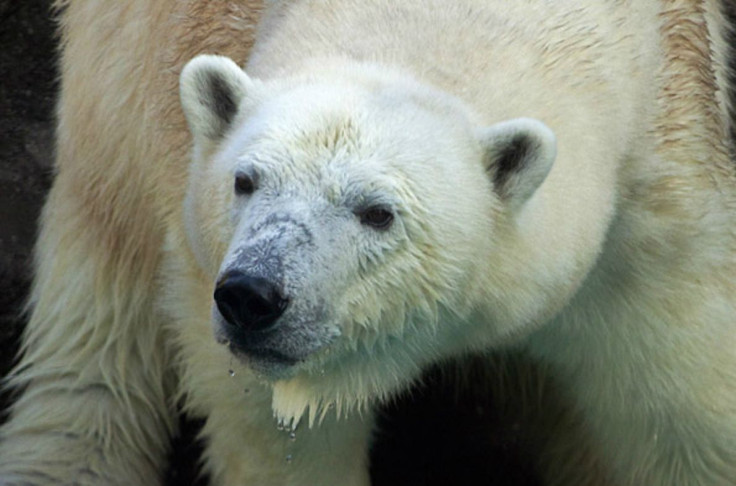No, A Chicago Zoo Polar Bear Is Not Stuck Indoors Due To Cold Weather

The so-called polar vortex was the news of the day for much of the United States on Tuesday, as Americans from New York to New Orleans dealt with ultra-low temperatures and other extreme weather conditions.
As humans bundled up and cranked the heat, many of them took the time to read and share news stories reporting that the weather was so bad that even polar bears can't handle it. But it turns out that the story is not quite what it seems.
The popular stories, some of which featured dramatic headlines like "It's Officially Too Cold For Lincoln Park Zoo's Polar Bear," mostly follow a similar rubric to a Monday report by DNAInfo Chicago. The attention-grabbing assertion behind the reports is that Anana, the sole polar bear at the Windy City's Lincoln Park Zoo, has been relegated to a "climate-controlled" indoor enclosure due to the subzero temperatures brought on by the Arctic winds sweeping across the U.S. over the past couple of days.
"She doesn’t typically enjoy the very cold much," Lincoln Park Zoo spokeswoman Sharon Dewar told DNAInfo. "Few of us are accustomed to this cold."
Dewar added that Anana, as a polar bear residing in an urban zoo, has less blubber than one that lives in the Arctic would, so that may make her more susceptible to cold than a wild polar bear.
DNAInfo reported on the phenomenon of the chilly polar bear in its sensationally headlined story, "Chicago Weather Too Cold Even For Zoo Polar Bear," and from there the news spread to news outlets across the country.
But International Business Times got in touch with Dewar on Tuesday, and she said there's a bit more nuance to the story than has been included in the narrative that has caught fire online.
"The zoo's polar bear, Anana, has been provided access to her outdoor exhibit today. She has a choice about whether or not she wants to be inside in a more temperature controlled climate (approximately 40-50 degrees), or outside. Today she has actually been enjoying some time outdoors," Dewar said Tuesday.
Explaining the policy further, Dewar clarified that Anana has been taken inside at times as the temperature has gotten excessively low, but she has not simply been banished to the indoors ever since the chill swept in.
"Every species housed at the zoo has certain temperature ranges to which it is comfortable and suitable in the elements," she said. "Any time the temperature dips below the low range, or heats up above the high range, the animals are taken into a temperature-controlled environment where they will be more comfortable."
In other words, the zoo's beloved 12-year-old polar bear may be taken inside during the worst parts of the polar vortex, but it is not under a days-long house arrest.
And there doesn't appear to be a real consensus over what the lowest comfortable temperature for polar bears actually is, according to Andrew E. Derocher, a professor with the Department of Biological Sciences at Canada's University of Alberta who has studied polar bears for three decades and lived north of the Arctic Circle for seven years.
"We don't know the lower critical temperature for polar bears: this would be the point at which they'd have to increase their metabolic rate or shiver to deal with cold. Polar bears have never been put into a freezing chamber and subjected to such experiments," Derocher told IBTimes on Tuesday. "For Arctic foxes, the lower critical temperature is well below -40 C [which is also -40 F]. We suspect polar bears being much larger but less well insulated by fur would show similar adaptations. Basically, most polar bears would do fine with the current weather in Chicago."
So don't worry, Anana will most likely be fine, even if she didn't have access to a warm place as the Artic winds slowly return to the icy landscape where her fellow polar bears roam free.
Still, zoos across the nation are taking steps to protect other species from the frigid air. Even Florida's Palm Beach Zoo is undertaking extensive measures to keep animals safe during the cold snap, according to spokeswoman Angela Cruz Ledford.
"When people think of the 'Sunshine State' of Florida, they think it’s constantly sunny and unfailingly warm. Most days, it is, but right now, it’s in the 50s, and the low temperatures tonight will be chilly for our zoo animals, who are used to the warmer temperatures," she told IBTimes on Tuesday.
"Many exhibits are being heated with heat lamps, and most of our reptiles have been pulled into heat barns ... As for primates like our monkeys, they have heat lamps and can go into their night boxes, which are fully heated. Last night, because it was so cold, we locked in our lemurs, siamangs [gibbons], Mexican spider monkeys, capuchins, Goeldi's monkeys and sloths. Carnivores like our jaguars, North American black bears, Malayan tiger and Florida panthers received hay."
© Copyright IBTimes 2024. All rights reserved.





















